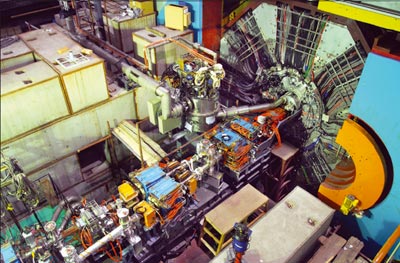
Image credit: BESIII/IHEP.
After five years of construction, the upgraded Beijing Electron–Positron Collider (BEPCII) and the new Beijing Spectrometer (BESIII) finished accumulating their first large data set of more than 100 million ψ(2S) events on 14 April. This is the world’s largest ψ(2S) data set. Data taking started on 6 March, following a scan of the ψ(2S) peak. During the following month, as machine commissioning continued, the peak luminosity of BEPCII increased steadily from 1.4 to 2.3×1032 cm–1s–2, with beam currents of 550 mA for both electrons and positrons.
The commissioning of the upgraded accelerator and the new detector began in summer 2008, with the first event observed on 18 July. Approximately 13 million ψ(2S) events were obtained last autumn, providing data for studies of the new detector and for calibration. The results show that the detector performance is as expected: efficiency, resolution and stability all meet specifications. The new data sample of 100 million ψ(2S) events will allow more-detailed studies of detector performance, as well as many physics analyses, for example of hc, ψc, and ηc charmonium states. After some accelerator studies, BEPCII and BESIII will now turn to running at the J/ψ peak, with the goal of collecting a high-statistics sample of J/ψ events.
BEPCII, the upgrade of BEPC at the Institute of High Energy Physics (IHEP) in Beijing, is a two-ring collider operating between 1 and 2.2 GeV beam energy in the charm energy region. It has a design luminosity of 1×1033 cm–2s–1 at 1.89 GeV, which is an improvement by two orders of magnitude on its predecessor. The BESIII detector features a beryllium beam pipe; a small-cell, helium-based drift chamber; a time-of-flight system; a CsI(Tl) electromagnetic calorimeter; a 1 T superconducting solenoid magnet; and a muon identifier using the magnet yoke interleaved with resistive plate chambers. The BESIII collaboration consists of groups from Germany, Italy, Japan, Russia, the US, as well as many Chinese Universities and IHEP.





